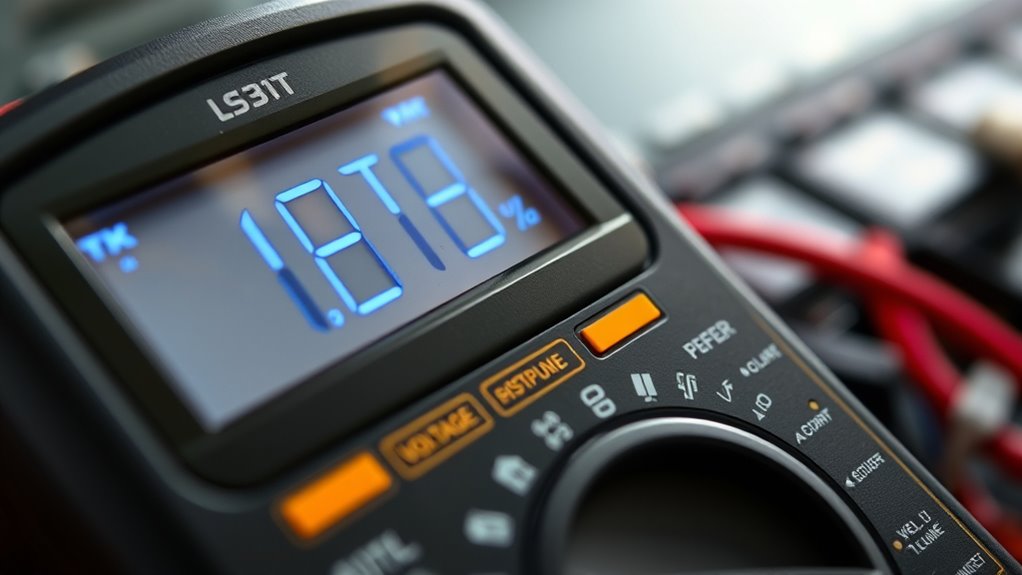Relying on voltage alone to determine your battery’s state of charge can be misleading because many factors influence voltage, including temperature, aging, discharge rates, and battery chemistry. Cold temperatures may lower voltage, while aging shifts voltage levels, making capacity seem different. High discharge rates cause voltage drops, hiding true charge levels. To get a more accurate picture, more advanced methods consider these factors—keep exploring to understand how precise SoC estimation works.
Key Takeaways
- Voltage varies with temperature, load, and aging, making it an unreliable sole indicator of actual battery charge.
- Different battery chemistries exhibit distinct voltage profiles, complicating standardized state-of-charge assessments.
- Internal resistance and rapid discharge rates cause voltage drops that do not accurately reflect remaining capacity.
- Aging reduces capacity and alters voltage behavior, leading to misleading voltage-based state-of-charge estimates.
- Combining modeling, temperature compensation, and current-based methods yields more accurate and reliable SoC measurements.
The Limitations of Voltage as a Measure of Battery Charge

While voltage is often used to estimate a battery’s state of charge, it can be misleading because it doesn’t account for the battery’s internal chemistry or operating conditions. Voltage stability varies with factors like load and age, which can skew readings and reduce state accuracy. For example, two batteries at the same voltage may have vastly different remaining capacities due to differences in chemistry or temperature. Relying solely on voltage can give you a false sense of security about your battery’s charge level. To get a clearer picture, it’s essential to contemplate other methods, such as coulomb counting or internal resistance measurements, which provide a more reliable assessment. Additionally, understanding battery chemistry helps in interpreting voltage readings more accurately. Recent advances in AI-powered diagnostics are also emerging to enhance battery health monitoring. Recognizing battery chemistry variations is crucial for accurate assessment, especially when conditions fluctuate or the battery ages. The influence of temperature effects on voltage readings can further complicate the measurement process. Moreover, internal resistance changes can significantly impact voltage readings under different operating conditions. Voltage alone cannot guarantee precise state of charge, especially under changing or demanding conditions.
How Temperature Affects Voltage and SoC Readings

Temperature plays a vital role in how accurately voltage reflects a battery’s state of charge. Thermal effects influence the internal chemistry and electrode behavior, causing voltage to fluctuate with temperature changes. When it’s cold, the voltage may drop even if the battery isn’t substantially discharged, leading to inaccurate SoC readings. Conversely, high temperatures can inflate voltage levels, making the battery appear more charged than it actually is. These fluctuations create calibration challenges because voltage measurements need to account for temperature variations to remain reliable. Without proper compensation, your SoC readings can be misleading, potentially causing you to overestimate or underestimate your battery’s capacity. Understanding temperature compensation and adjusting for thermal effects are essential for accurate voltage-based SoC assessments. Proper calibration and understanding of thermal influences are key to maintaining accurate readings across varying environments. Additionally, implementing temperature sensors into the battery management system can significantly improve the accuracy of SoC readings under different operating conditions, especially when combined with tuning Hyundai vehicles to optimize energy efficiency and performance. Recognizing how thermal effects impact voltage readings is crucial for developing reliable SoC estimation methods.
The Impact of Battery Chemistry and Aging on Voltage Levels

Different battery chemistries naturally have distinct voltage profiles, which means that the type of chemistry used directly influences the voltage levels you see during operation. For example, lithium-ion and lead-acid batteries each have characteristic voltage ranges that vary throughout discharge. As batteries age, aging effects like capacity loss and internal resistance increase, which can cause voltage levels to shift or become less predictable. These changes make it harder to accurately judge the state of charge based solely on voltage. Over time, aging effects can lead to lower voltage readings at the same charge level, misleading you about remaining capacity. Battery chemistry plays a crucial role in how voltage behaves during use and aging. Additionally, the internal resistance of a battery increases with age, further complicating voltage-based estimations. An understanding of battery degradation processes is essential to interpret voltage fluctuations accurately. The performance of a battery can also be significantly affected by environmental factors such as temperature, which impact voltage readings as well. Recognizing how aging effects influence voltage helps you better interpret voltage readings and avoid false assumptions about your battery’s true state of charge.
Why Voltage Doesn’t Account for Different Discharge Rates

Voltage readings alone can be misleading because they don’t reflect how quickly a battery is discharging. Different discharge rates impact voltage stability, making two batteries with the same voltage appear fully charged, even if one is draining faster. When you draw high current, the battery’s voltage drops more sharply due to discharge dynamics, while at lower rates, voltage remains relatively stable. This variability shows that voltage isn’t a reliable indicator of the actual State of Charge across different loads. Faster discharge causes more significant voltage sag, which can mask the true capacity left. Additionally, Preppy Dog Names can be used to create memorable, distinctive labels for your battery monitoring equipment, helping you quickly identify different systems or conditions. Understanding how discharge rate effects influence voltage helps you recognize why voltage alone doesn’t accurately reflect a battery’s remaining charge, especially during rapid or uneven drain conditions. Recognizing the impact of air quality considerations on battery performance can also help in managing battery health more effectively.
Alternative Methods for More Accurate State of Charge Estimation

To achieve a more accurate estimate of a battery’s State of Charge, relying solely on voltage measurements isn’t enough. You can improve accuracy using advanced methods like battery modeling and calibration techniques. These approaches consider factors such as internal resistance, temperature, and current flow, which voltage alone overlooks.
Here are three ways to enhance estimation:
- Use battery modeling to simulate real-world behavior and predict SOC more precisely.
- Apply calibration techniques regularly to account for aging and capacity changes.
- Incorporate current-based algorithms, like Coulomb counting, combined with models for better accuracy.
These methods help overcome voltage limitations, providing a more reliable picture of your battery’s true charge state.
Frequently Asked Questions
How Do Battery Management Systems Estimate Actual Battery Capacity?
You can estimate actual battery capacity by monitoring voltage fluctuations and analyzing charge and discharge cycles. Your battery management system uses algorithms to interpret voltage changes, but since voltage alone isn’t a reliable indicator of capacity, it also considers current flow, temperature, and historical data. This combined capacity estimation helps guarantee accurate readings, preventing overcharges or deep discharges, and optimizes battery performance and lifespan.
Can Software Algorithms Improve Voltage-Based State of Charge Accuracy?
Yes, software algorithms can improve voltage-based state of charge accuracy. By accounting for voltage fluctuations caused by temperature changes and load variations, software calibration adjusts the readings in real-time. This helps you get a more reliable estimate of your battery’s true capacity. While voltage alone isn’t perfect, advanced algorithms refine measurements, making your battery management system smarter and more precise, ultimately extending your battery’s lifespan and performance.
What Role Does Internal Resistance Play in Voltage and Soc Readings?
Internal resistance markedly impacts voltage and SOC readings because it causes voltage fluctuations under load, making accurate measurement tricky. When resistance increases, it drops the voltage, leading you to underestimate the battery’s true state of charge. You should consider internal resistance variations, especially during high or uneven loads, to get a more reliable SOC reading. Monitoring and compensating for internal resistance helps improve overall accuracy in battery management.
Are There Specific Battery Types Better Suited for Voltage-Based Soc Measurement?
You’ll find that lithium-ion batteries are better suited for voltage-based SOC measurement because of their stable voltage during discharge. Unlike lead-acid or nickel-based chemistries, which experience significant voltage drops, lithium-ion’s voltage stability makes it easier to estimate SOC accurately. This stability simplifies readings, reducing the impact of internal resistance variations. So, if you want reliable voltage-based SOC, choosing batteries with consistent chemistry like lithium-ion is your best bet.
How Do User Habits Influence the Accuracy of Voltage-Based State of Charge Estimates?
You can influence the accuracy of voltage-based SOC estimates through your user behavior and charging patterns. Frequent, consistent charging helps maintain stable voltage readings, making estimates more reliable. Conversely, irregular charging, deep discharges, or rapid charging can cause voltage fluctuations that mislead the system. By adopting steady charging habits and avoiding extreme discharges, you improve the precision of voltage-based SOC measurements, ensuring your battery’s state of charge is more accurately reflected.
Conclusion
Remember, relying solely on voltage to gauge your battery’s state of charge is like trying to judge a book by its cover—deceptive and unreliable. Temperature shifts, aging, and chemistry all play tricks on voltage readings, making them poor indicators of true charge. Instead, consider modern methods that account for these variables, much like using a compass instead of a sundial in cloudy weather. Trust these smarter tools to keep your battery life on the right course.









